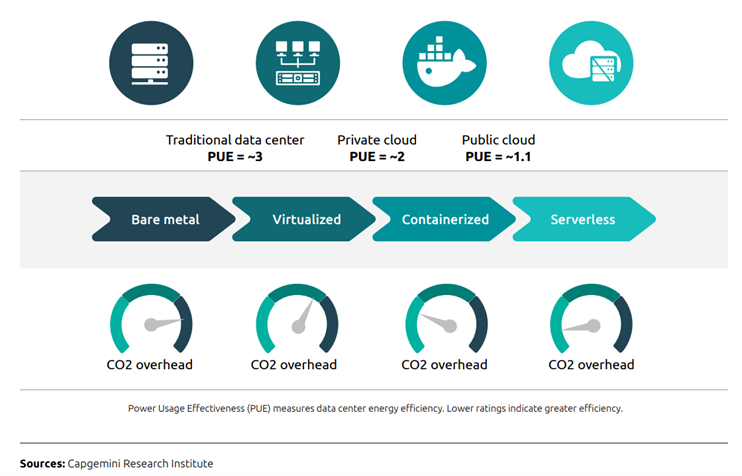Sustainable Application Development
By 2025, Global Enterprise IT will generate CO2 equal to 463 Million cars or 256 million homes.
Training an AI instance to respond to voice, can generate the same CO2 emissions as a roundtrip flight from New York to San Francisco. IT energy consumption has is tripled in 5 years. Similarly, Data generated by IoT devices is expected to quadruple to 73.1 zettabytes by 2025.
As Capgemini’s commitment to NetZero Carbon footprint, we continue to innovate new transformation paths for sustainability optimizations in processes and technology for ourself, our suppliers and customer eco system. Datacenter migration to Cloud has been popular moves many enterprises has taken to reduce the CO2 footprint by 30-40%. One area that often overlooked is software development process and application architecture, which can be a significant contributor to carbon emissions.
Focus areas in optimizing Carbon footprint in Applications:
- Application Architecture
- Software development delivery model
- End to end Automation
- Monitoring for cost, resources and co2
- Landing Zone selection
Modern Architecture – Modern application architectures like microservices and containerization can help reduce the carbon footprint of software development by making it easier to scale applications efficiently. By breaking applications down into smaller, more modular components, development teams can reduce the number of resources required to run and test each component. By Containerization using Docker, AKS, EKS, one can deploy applications more efficiently, reducing the amount of energy required to provision and maintain infrastructure. Serverless Microservices based architecture can further reduce the resource consumption by minimizing resource requirements with automation to scaleup the capacity rapidly based on performance or usage demands. Following illustration can give a perspective of how the CO2 footprint significantly reduces with Virtualization. Higher leverage of Serverless or containerization can bring significant benefits.
Fig: How Power Usage and CO2 overheads vary based on hosting

Another important practice is the use of energy-efficient coding practices. This includes the optimization of code to reduce resource consumption, such as reducing the number of database queries and optimizing resource usage during runtime.
Automated DevOps - DevOps is a software development practice that emphasizes the integration of development and operations teams to improve the quality and speed of software delivery. Cloud-based automated DevOps takes this one step further by using cloud landing zones and automation tools to increase speed and ability to automate, as well as reduce the carbon footprint of software development and deployment cycles.
Continuous integration involves the automated building and testing of code changes. This allows developers to identify and fix issues quickly, reducing the amount of energy required to test and deploy the application.
Continuous delivery involves the automation of the application deployment process. This includes the packaging and deployment of the application, as well as the configuration of the underlying infrastructure. By automating this process, organizations can significantly reduce the time and effort required to deploy the application, resulting in a smaller carbon footprint.
Continuous deployment takes automation one step further by automatically deploying the application to production. This reduces the need for manual intervention, reducing the amount of energy required to deploy the application.
CI/CD pipelines automation for integration, build, testing, and deployment is key in Agile-DevOps delivery model while developing modular software architecture. Traditional unit testing, functional testing and regression testing tends to have 60-70% higher resource consumption. With completely automated build and testing can help in reduce per release cost, resources, and CO2 footprint by more than 80%.
Cloud PaaS
Though Cloud IAAS provides good commercial and sustainability alternative to private datacenter hosted servers, containerized landing zone which often overlaps with IAAS and PAAS is a better alternative to VMs due to smaller size and ability to scale out on demand through infrastructure as a code automation and Kubernetes. PAAS based cloud native services are highly optimized for resource consumption which is optimized for smallest size and time scale. With IAAC and CI/CD pipeline automation dynamic resource allocation for development, build, test, integration, deployment can reduce the cloud resource consumption by up to 85%.
Review and Monitoring
With Cloud FinOps, one can monitor the financial aspects of cloud consumption during the entire lifecycle of the application. Many code analysis tools now offer the sustainability analysis of the code which is quite interesting for IT teams to consider reviewing sustainability of the code closely. Cloud-based DevOps platforms can provide real-time monitoring and optimization capabilities that enable us to identify and resolve performance issues and optimize resource utilization. This reduces energy consumption and carbon emissions associated with running inefficient applications and infrastructure. Capgemini has proven best practices and solutions such as eAPM which help us visualizing the sustainability aspect of IT landscape and recommend the roadmap for improvement of the CO2 footprint. I like the case of BMW with 5000+ apps which we evaluated against transformation and sustainability. We managed to assist in reducing the CO2 footprint by almost half.
Reducing the carbon footprint in application development requires the adoption of modern application architecture, sustainable development best practices, Cloud PaaS, and automated DevOps. By breaking down applications into smaller, independent microservices, incorporating environmental considerations into the software development process, leveraging cloud PaaS, and automating the software development and deployment process, organizations can significantly reduce their carbon footprint while improving the speed and quality of software delivery. Therefore, organizations should prioritize sustainability while developing software applications and leverage these practices to achieve their environmental goals.
To find out more about Sogeti’s cloud transformation offerings, get in touch today

References and additional information :
Capgemini Research - Why cloud is key to business sustainability
Capgemini Blog - Containerization and Sustainability
Capgemini Blog - Measuring Energy Efficiency
AWS well architect framework – Sustainability Pillar
Microsoft Sustainability Design Principles
- Mahesh KoliVP Cloud Transformation, Sogeti Ireland
 Mahesh KoliVP Cloud Transformation, Sogeti Ireland
Mahesh KoliVP Cloud Transformation, Sogeti Ireland


![[Missing text '/pageicons/altmail' for 'English']](/Static/img/email.png)